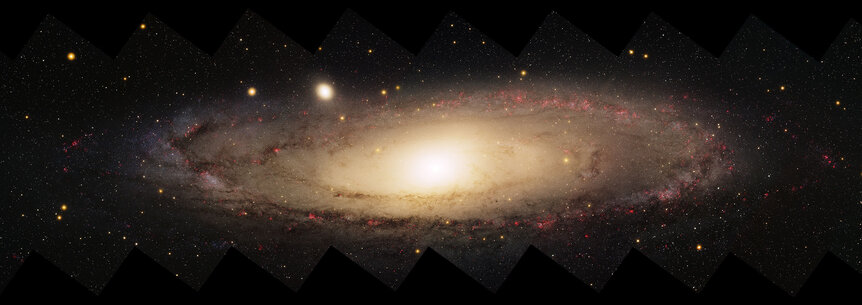Create a free profile to get unlimited access to exclusive videos, sweepstakes, and more!
A N D R O M E D A

Have you had your “holy wow!” moment for the day? No? Then let me help you. Presenting the Andromeda galaxy. And oh boy, is it a presentation!
Nice, eh? Now, I had to shrink the image to fit the 1,440 pixel width of the blog (which is usually 590 pixels, but for you, dear BABloggees, this just cried out to be wider). How much did I shrink it? By a factor of 30.
The full resolution JPG is a staggering 48,327 x 12,185 pixels, and weighs in at 340 Mb! The TIF version is 717 Mb, just so’s you know.
This jaw-dropping image of Andromeda (also called M31) was put together by my friend, astronomer and astrophotographer extraordinaire Travis Rector. The data were from the Local Group Survey, a project to look at star-forming regions of nearby galaxies*. The mosaic uses 10 separate pointings of the Kitt Peak 4-meter Mayall telescope to cover the galaxy completely. The image used five filters: ultraviolet, blue, visible/yellow, infrared, and a narrow-band H-α. The first four highlight stars and dust in the galaxy, and the last picks out star-forming nebulae, which litter Andromeda.
In fact, I decided to choke my bandwidth and grab the whole image just so I could show you a string of such nebulae in full resolution:
Yegads. This chain of nebulae is located at about the 4:00 position, along the outer spiral arm. See if you can find it.
The resolution on this image is amazing, especially considering the full images covers about 3.5° of the sky—you could fit seven full Moons across this picture!
The galaxy itself is a favorite. It’s the closest big spiral to the Milky Way, about 2.5 million light years away. As galaxies go, that’s our next-door neighbor … but be aware that it’s still 25 quintillion kilometers away! Or 15 quintillion miles, if you prefer (or 82 sextillion feet, or a cool septillion inches. I quite enjoy large numbers).
Andromeda is visible to the unaided eye, and in fact this is a good time to see it; it’s up high enough to spot in the northeast around 10 p.m. this time of year for most northern hemisphere folks. Binoculars show it to be an elongated smudge, and a small ‘scope will start to show some details, like M32, a dwarf satellite galaxy of Andromeda (seen in the full image here to the upper left of the bigger galaxy’s center; another satellite galaxy, M110, is just outside the field of view below M31). I can’t tell you how many times I’ve viewed M31, from using my own eyes up to Hubble Space Telescope imaging.
It’s rare to get both a deep, high-resolution image like this as well as cover the entire width of the galaxy. Travis did an amazing job here. As usual.
Update (Sep. 3, 2014 at 22:30 UTC): To be clear about credit, I contacted the Local Group Galaxy Survey lead Phil Massey, who added: "The LGGS M31 images were taken with the Mayall 4-meter telescope at Kitt Peak National Observatory by a team of astronomers led by Phil Massey (Lowell Observatory), and included Knut Olsen, George Jacoby, Chris Smith (NOAO), Paul Hodge (University of Washington), and Wayne Schlingman (OSU); the survey and analysis was partially funded by the NSF."





























